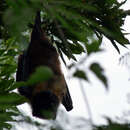fi
nimet breadcrumb-navigoinnissa


Communication Channels: tactile ; acoustic ; chemical
Other Communication Modes: pheromones
Perception Channels: visual ; tactile ; acoustic ; chemical
Deforestation, hunting, and typhoons are threats to populations of P. dasymallus. Clearing of forest for agriculture takes away roosting and food supplies for these bats. Pteropus dasymallus formosus is now believed to be extinct in the wild. The extinction of this subspecies in the wild is believed to have been caused by hunting and deforestation (Thatcher 2004). Typhoons have a greater affect on forest structure because of deforestation. Smaller patches of trees are then more easily knocked down by the wind leaving less and less habitat. Reproductive factors also lead to conservation problems. Ryukyu flying-foxes have a low reproductive rate, making them unable to recover quickly after population declines. (Thatcher 2004, Mickleburgh et al. 1992, Species Under Threat 1998).
US Federal List: no special status
CITES: appendix ii
IUCN Red List of Threatened Species: near threatened
Pteropus dasymallus do eat commercial fruit crops.
The 5 subspecies pollinate and disperse seeds important to the timber industry, food crops, and some medicinal plants.
Positive Impacts: pollinates crops
Ryukyu flying-foxes are economically important because they pollinate wild and commercial plants.
Ecosystem Impact: disperses seeds; pollinates
Pteropus dasymallus feeds almost entirely on plants and their products. Fruit makes up the bulk of the diet. Figs seem to be one of the animal's favorites. Other plant products that are eaten are the flowers and leaves. Flowers are eaten in the spring and leaves year round. Insects may also be a part of the diet of this species in the summer and autumn. One study showed that P. d. dasymallus has a more diverse diet than any other pteropodid bats ever studied. Their diet includes bark, 17 species of fruit, nine species of leaves, five species of flowers, and eight species of insects on Kuchinoerabu Island.
Animal Foods: insects
Plant Foods: leaves; fruit; flowers
Primary Diet: herbivore (Folivore , Frugivore ); omnivore
Pteropus dasymallus (Ryukyu flying-fox) range from the Ryukyu islands of Japan (Kuchinoerabu, Takara, Okinawa, Ishigaki, Iriomote, Hatoma, Obama, Yonakuni and some smaller islands) through parts of Taiwan (Kashoto Island, east coast Taiwan, and the Daito Islands).
Biogeographic Regions: oriental (Native )
Other Geographic Terms: island endemic
Ryukyu flying-foxes use forests for daytime roosting.
Terrestrial Biomes: forest ; rainforest
Average lifespan
Status: captivity: 24 years.
Ryukyu flying-foxes are in the suborder Megachiroptera. Key characteristics of this suborder are that they have a well developed premaxillary bone, a postorbital process is present, they lack a tragus and a noseleaf, and their teeth are adapted for eating fruit. There are 5 subspecies of Ryukyu flying-foxes. They are P. d. daitoensis (Daito fruit bat), P. d. dasymallus (Erabu fruit bat), P. d. formosus (Taiwanese fruit bat), P. d. inopinatus (Orii's fruit bat), and P. d. yayeyamae (Yaeyama fruit bat). There are some character variations among the subspecies. Pteropus dasymallus daitoensis has brown wings and a yellow belly and back. The sides of the back are brown. The body is 221 mm long and forearm length 134 mm. Pteropus dasymallus dasymallus is the largest in size and darkest in color of the subspecies. The fur coloration consists of a blackish head and face, body is usually dark brown to black, and a cream colored area around neck. The forearm measured at around 137 mm. Pteropus dasymallus formosus is thought to be extinct in the wild. Pteropus dasymallus inopinatus has a brown muzzle, and it has a patch of darker fur that interrupts the white collar around its neck. Pteropus dasymallus inopinatus has an exposed lacrimal foramen. Pteropus dasymallus yayeyamae is the smallest in size among the 4 wild subspecies. The fur color varies on the dorsal and ventral sides of this subspecies. The head is usually brown and the neck a cinnamon color.
Average mass: 435 g.
Other Physical Features: endothermic ; homoiothermic; bilateral symmetry
Sexual Dimorphism: sexes alike
Pteropus dasymallus have low reproductive rates. In most fruit bats females don't give birth for the first time until they are one or two years old (Mickleburgh et al. 1992). One young is born at a time with a gestation period of 4 to 6 months. In P. d. daitoensis mating takes place between November and early January and birth between May and June (Thatcher 2004).
Breeding season: Mating takes place between November and early January
Range number of offspring: 1 (low) .
Average number of offspring: 1.
Range gestation period: 4 to 6 months.
Range age at sexual or reproductive maturity (female): 1 to 2 years.
Key Reproductive Features: seasonal breeding ; gonochoric/gonochoristic/dioecious (sexes separate); sexual ; viviparous